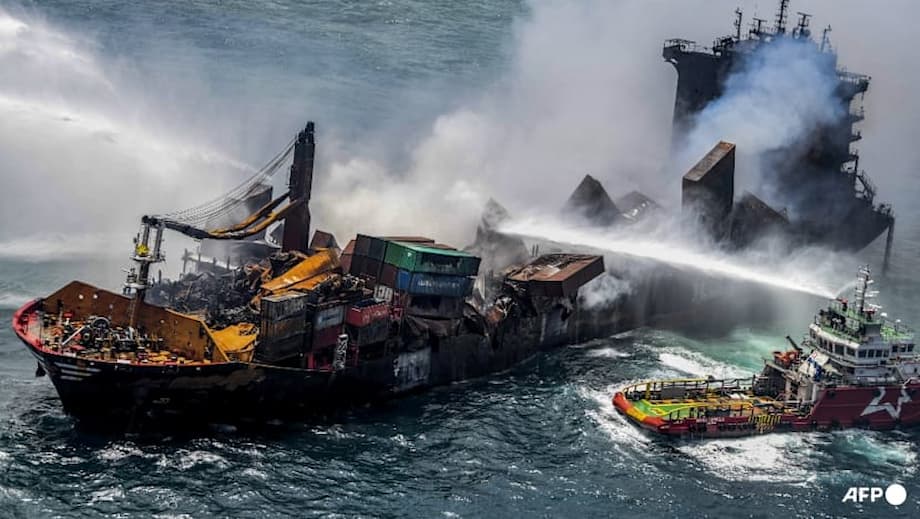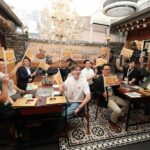How a ship fire turned into a billion dollar legal battle
Sri Lanka’s Supreme Court has ordered the owner, operator, and local agent of the container ship MV X-Press Pearl to pay 1 billion dollars for the catastrophic marine pollution that followed a fire and sinking off Colombo in 2021. The ruling, delivered in late July 2025, set an aggressive payment schedule and created new bodies to quantify losses and channel funds to environmental restoration and affected communities. Faced with that order, the Singapore based operator has refused to pay, arguing that the judgment violates long standing limits on maritime liability. The ship’s local agent in Sri Lanka has since made a token payment of about 1 million dollars, underscoring a widening standoff with high stakes for coastal communities, environmental law, and the global shipping industry.
- How a ship fire turned into a billion dollar legal battle
- What happened off Sri Lanka’s coast
- The Supreme Court’s ruling and what it ordered
- A token payment amid a refusal to pay
- Why liability limits are at the heart of the fight
- Environmental toll from fire, chemicals, and nurdles
- Fisherfolk, tourism, and the cost to livelihoods
- Enforcement and what happens next
- Global shipping watches the case
- Key Points
The court framed the disaster as a profound breach of public trust and applied a strict standard of responsibility. It embraced the polluter pays principle and found the corporate defendants jointly and severally liable, a legal term that allows the state to pursue any one of them for the full amount if others do not pay. Judges also adopted an absolute duty of care for hazardous activities, which places a heavy burden on companies that transport dangerous cargo. The decision reflects the scale of the damage. Microplastic pellets known as nurdles spread along an estimated 80 kilometers of shoreline, fishing was banned for months, and investigators documented widespread harm to marine life and habitats.
Under the ruling, money is to be paid to the Secretary to the Treasury in trust and directed to a dedicated fund for clean up, restoration, and compensation. An independent compensation commission must verify losses and recommend additional payments if needed. The court warned that further sums could be ordered as scientific assessments progress. While Sri Lanka’s government has said it will seek advice from the Attorney General on enforcement, the ship operator’s refusal, the local agent’s token payment, and a separate effort by the company to cap liability in London have set up a direct clash over who pays, how much, and under what law.
What happened off Sri Lanka’s coast
The MV X-Press Pearl, a Singapore flagged container ship barely months into service, anchored off Colombo in May 2021 with a known problem on board. A container of nitric acid had been leaking on the previous leg of its voyage. Requests to offload that cargo at earlier ports, including Hamad in Qatar and Hazira in India, were not granted. While at anchor near Colombo, a fire broke out and burned for nearly two weeks. An explosion followed, the crew was evacuated, and the badly damaged ship sank in early June within sight of shore.
A leak that went unanswered
The vessel carried 1,486 containers, 81 of them holding hazardous materials such as acids and lead ingots. The fire and sinking released a toxic mix of chemicals, debris, and an enormous volume of plastic pellets into the sea. These lentil sized pellets, called nurdles, are the raw material used to make plastic products. Billions of them drifted onto beaches along Sri Lanka’s western coastline. Authorities imposed a wide fishing ban to protect public health and marine stocks. Sri Lankan and Indian ships fought the blaze and worked to contain pollution, while salvors and local agencies attempted to remove debris and survey the wreck. Years later, residues, including nurdles tangled in beach sand, continue to be found.
The Supreme Court’s ruling and what it ordered
On July 24, 2025, Sri Lanka’s Supreme Court issued a sweeping decision. It found the owner, operator, and local agent jointly and severally liable for environmental and economic damage. The court said corporate actors engaged in inherently dangerous activities owe an absolute and non delegable duty to prevent harm. It concluded that mismanagement and a lack of transparency, including the withholding of critical information from Sri Lankan authorities, worsened the crisis. The court criticized state shortcomings but held that key port officials acted with due diligence based on the information they had.
The order set an initial compensation sum of 1 billion dollars to be paid within one year. The first installment, not less than 250 million dollars, was due by late September 2025, with a further minimum of 500 million dollars due within six months. Money must be held in a special account titled the MV X-Press Pearl Compensation and Environment Restoration and Protection Fund. The court directed the creation of two oversight bodies: an independent compensation commission to assess harm and allocate payments, and a marine and coastal environment restoration committee to guide recovery. The Attorney General was instructed to expedite criminal investigations and report back to the court at regular intervals. A compliance review hearing was set for late September 2025, with the court retaining continuing jurisdiction.
A token payment amid a refusal to pay
As the first deadline approached, the ship’s Sri Lankan agent, Sea Consortium, deposited about 300 million rupees, roughly 1 million dollars, into the Treasury in what it described as a good faith gesture. The company said it did not have the financial capacity to pay more and that the court had held the agent responsible for any non compliance by the overseas owner and operator. The token payment stood in stark contrast to the 1 billion dollar order, and it came as the Singapore based operator publicly rejected the judgment.
Shmuel Yoskovitz, the chief executive of X-Press Feeders, has argued that the payment order contradicts the foundation of maritime commerce. He said the company has already spent about 170 million dollars on wreck removal, seabed and beach cleaning, and support for affected fishing communities, and that any future payment must be final and in line with maritime conventions that cap liability. After outlining his position, he described wider consequences he believes would follow compliance.
“Any such payment would have wide ranging implications for global shipping and set a dangerous precedent. The basis of maritime trade rests on the limitation of liability, and this judgment undermines that principle.”
Environmental activist Hemantha Withanage, who was among the petitioners in the case, confirmed that he received official documentation of the Sri Lankan agent’s payment to the Treasury. He has pressed for full accountability and for the court ordered bodies to be established and funded so they can compensate affected families and restore damaged ecosystems.
“The payment represents a token amount against the scale of harm. We have been officially informed of the deposit, but the order is for 1 billion dollars and it needs to be implemented for communities and the environment.”
Why liability limits are at the heart of the fight
Shipping law has long allowed owners and operators to cap their financial exposure after accidents. The main instrument is the Convention on Limitation of Liability for Maritime Claims, which ties the maximum payout to a vessel’s size and other factors. The aim is to keep insurance predictable, encourage investment in fleets, and ensure that ships continue to carry essential cargo even when risks are present. Protection and indemnity insurers price coverage around these limits. Without them, operators warn that premiums would rise and smaller companies could be pushed out of the market.
The X-Press Pearl case tests how those limits interact with national environmental law. X-Press Feeders has obtained an order from London’s Admiralty Court seeking to limit liability to about 19 million pounds. Sri Lanka is challenging that position and has also filed a case in the Singapore International Commercial Court, which remains on hold while the London limitation case proceeds. In Colombo, the Supreme Court emphasized domestic jurisdiction where the harm occurred and adopted absolute liability for hazardous activities, regardless of international caps. That sets up a legal and practical question. How, and where, can a Sri Lankan judgment be enforced against foreign companies that do not consent to pay, especially when a court in another country has ruled that liability is capped at a far lower sum?
Courts typically require a fresh recognition process to enforce a foreign judgment. States can also act against local assets or local affiliates. The Supreme Court in Colombo has directed police and prosecutors to pursue criminal proceedings if parties fail to comply and are present in Sri Lanka. Even so, the gap between a 1 billion dollar domestic order and a far smaller international liability cap reveals the core tension in transboundary pollution cases.
Environmental toll from fire, chemicals, and nurdles
The sinking released what scientists and authorities describe as the world’s largest known marine plastic pellet spill. Researchers estimate that 70 to 75 billion nurdles entered Sri Lankan waters. These pellets are buoyant and sticky, which makes them hard to remove and easy to ingest by fish, turtles, and seabirds. They also attract and concentrate other toxins in seawater. The pellets blanketed beaches for months. Volunteers, government agencies, and contractors collected large volumes, yet pellets keep resurfacing after storms and tides wash through coastal sand.
Chemicals on board added to the hazard. Nitric acid exposure can burn skin, eyes, and lungs. Fire and heat may have produced nitrogen oxides, which raised fears about air quality near shore. Containers holding other dangerous substances were lost overboard or damaged. The combustion of cargo and plastics released a complex mixture of pollutants. The wreck itself remains a potential source of contamination, and salvage and monitoring operations have had to contend with monsoon conditions and safety risks around the site.
Marine life suffered immediate and recorded losses. Official assessments documented the deaths of hundreds of sea turtles, dozens of dolphins, and several whales along with extensive damage to coral reefs and nearshore habitats. Fish die offs and unusual blooms were reported in the aftermath. Scientists warn that effects on biodiversity and food chains will play out across years. Microplastics break down into even smaller particles that can pass through gills and digestive systems, and they can move up the food web. The stress on coastal ecosystems compounds other pressures such as overfishing and warming waters.
Fisherfolk, tourism, and the cost to livelihoods
Fishing bans stretched along an estimated 80 kilometer zone on the western coast, cutting off income for thousands of families. Boats sat idle. Buyers and processors lost work. In many coastal towns, fishing is the main source of cash income and nutrition. Compensation processes started but have not fully closed the gap left by months without earnings. Communities report ongoing impacts as debris resurfaces and buyers question the safety of catch from affected areas.
Tourism also took a hit. Beaches fouled by pellets and burnt cargo deterred visitors and reduced revenue for small hotels, guesthouses, and food vendors. Public health messaging warned people not to touch debris. Clean up crews removed truckloads of mixed material, but confidence in beach safety has been slow to return in some areas. Research on the social effects of the spill points to rising public awareness, calls for better plastic waste management, and pressure for stronger rules on hazardous cargo.
Enforcement and what happens next
The Supreme Court’s judgment is final under Sri Lankan law. It retained jurisdiction to oversee implementation and set a review hearing for late September 2025. The Attorney General must report on the status of investigations and on steps taken to establish the compensation commission and the restoration committee. Petitioners want the new bodies up and running so they can vet claims and roll out payments to fishers and other affected groups. The court also said it may order further payments after the full harm is independently verified.
Enforcement against foreign companies will likely involve a mix of domestic pressure, cross border legal actions, and diplomacy. If the defendants hold assets or conduct business in Sri Lanka, authorities could pursue attachment or other measures tied to non compliance. Recognition of the judgment in other jurisdictions may be tested against competing orders such as the London limitation decision. For corporate officers and crew within Sri Lanka, the court opened the path to criminal proceedings for failure to comply. The ship’s Russian captain has remained under a travel ban for years, a situation that the company says it sought to resolve with a payment that was not accepted.
Global shipping watches the case
Industry groups and insurers are watching closely because the decision challenges the premise that well defined caps keep risk insurable. If exposure becomes uncertain and potentially unlimited, insurers may raise premiums, exclude certain routes or cargoes, or demand more robust risk controls. Operators may push for clearer protocols when ships report hazardous leaks at sea, and for port states to create rapid response channels to discharge dangerous cargo when safety requires it. The court’s finding that the owner, operator, and agent withheld critical information places a spotlight on transparency and emergency communication as a matter of corporate governance.
The United Nations office in Sri Lanka welcomed the court’s decision as a step toward accountability and called the refusal to pay deeply concerning. The statement urged the parties to consider the scale of harm and to support justice for affected communities and the ecosystem.
“The refusal to comply is deeply concerning. Polluters should meet their responsibilities so that restoration and justice can move ahead for people and the environment.”
For countries along busy shipping routes, the case underscores the balance between enabling trade and protecting coastal environments. Sri Lanka’s judgment emphasizes domestic authority to remedy harm within its waters and sends a signal that hazardous cargo incidents will be met with strong legal responses. For shipowners, the outcome increases pressure to document and disclose problems early, invest in safety and training, and work with ports on credible contingency plans.
Key Points
- Sri Lanka’s Supreme Court ordered 1 billion dollars from the MV X-Press Pearl owner, operator, and local agent for 2021 marine pollution.
- The operator refused to pay, citing global maritime liability limits and warning of wider industry impacts.
- The Sri Lankan agent made a token payment of about 1 million dollars to the Treasury, saying it lacked capacity to pay more.
- The court applied joint and several liability and an absolute duty of care for hazardous activities.
- Installments include at least 250 million dollars due by late September 2025 and at least 500 million dollars within six months.
- Funds go to a dedicated compensation and restoration account overseen by a new commission and a restoration committee.
- Investigators documented massive microplastic pollution, a months long fishing ban, and hundreds of recorded marine animal deaths.
- X-Press Feeders says it has spent about 170 million dollars on wreck removal, cleanup, and support for fishers.
- The company seeks to cap liability in London at about 19 million pounds, while a Singapore case is paused pending that process.
- A compliance hearing in Sri Lanka is scheduled for late September 2025, with the court keeping ongoing oversight.




